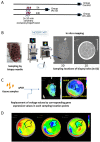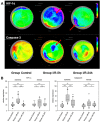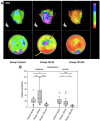Intrinsic remote conditioning of the myocardium as a comprehensive cardiac response to ischemia and reperfusion
- PMID: 28978029
- PMCID: PMC5620169
- DOI: 10.18632/oncotarget.18438
Intrinsic remote conditioning of the myocardium as a comprehensive cardiac response to ischemia and reperfusion
Abstract
We have previously shown that distal anterior wall ischemia/reperfusion induces gene expression changes in the proximal anterior myocardial area, involving genes responsible for cardiac remodeling. Here we investigated the molecular signals of the ischemia non-affected remote lateral and posterior regions and present gene expression profiles of the entire left ventricle by using our novel and straightforward method of 2D and 3D image reconstruction. Five or 24h after repetitive 10min ischemia/reperfusion without subsequent infarction, pig hearts were explanted and myocardial samples from 52 equally distributed locations of the left ventricle were collected. Expressional changes of seven genes of interest (HIF-1α; caspase-3, transcription factor GATA4; myocyte enhancer factor 2C /MEF2c/; hexokinase 2 /HK2/; clusterin /CLU/ and excision repair cross-complementation group 4 /ERCC4/) were measured by qPCR. 2D and 3D gene expression maps were constructed by projecting the fold changes on the NOGA anatomical mapping coordinates. Caspase-3, GATA4, HK2, CLU, and ERCC4 were up-regulated region-specifically in the ischemic zone at 5 h post ischemia/reperfusion injury. Overexpression of GATA4, clusterin and ERCC4 persisted after 24 h. HK2 showed strong up-regulation in the ischemic zone and down-regulation in remote areas at 5 h, and was severely reduced in all heart regions at 24 h. These results indicate a quick onset of regulation of apoptosis-related genes, which is partially reversed in the late phase of ischemia/reperfusion cardioprotection, and highlight variations between ischemic and unaffected myocardium over time. The NOGA 2D and 3D construction system is an attractive method to visualize expressional variations in the myocardium.
Keywords: LV remodelling; NOGA mapping; cardioprotection; gene expression; ischemia/reperfusion.
Conflict of interest statement
CONFLICTS OF INTEREST None.
Figures






References
-
- Pavo N, Zimmermann M, Pils D, Mildner M, Petrasi Z, Petnehazy O, Fuzik J, Jakab A, Gabriel C, Sipos W, Maurer G, Gyongyosi M, Ankersmit HJ. Long-acting beneficial effect of percutaneously intramyocardially delivered secretome of apoptotic peripheral blood cells on porcine chronic ischemic left ventricular dysfunction. Biomaterials. 2014;35:3541–3550. - PubMed
-
- Pavo N, Lukovic D, Zlabinger K, Zimba A, Lorant D, Goliasch G, Winkler J, Pils D, Auer K, Jan Ankersmit H, Giricz Z, Baranyai T, Sárközy M, et al. Sequential activation of different pathway networks in ischemia-affected and non-affected myocardium, inducing intrinsic remote conditioning to prevent left ventricular remodeling. Sci Rep. 2017;7:43958. - PMC - PubMed
-
- Murry CE, Jennings RB, Reimer KA. Preconditioning with ischemia: a delay of lethal cell injury in ischemic myocardium. Circulation. 1986;74:1124–1136. - PubMed
-
- Ferdinandy P, Schulz R, Baxter GF. Interaction of cardiovascular risk factors with myocardial ischemia/reperfusion injury, preconditioning, and postconditioning. Pharmacol Rev. 2007;59:418–458. - PubMed
Grants and funding
LinkOut - more resources
Full Text Sources
Other Literature Sources
Research Materials
Miscellaneous

